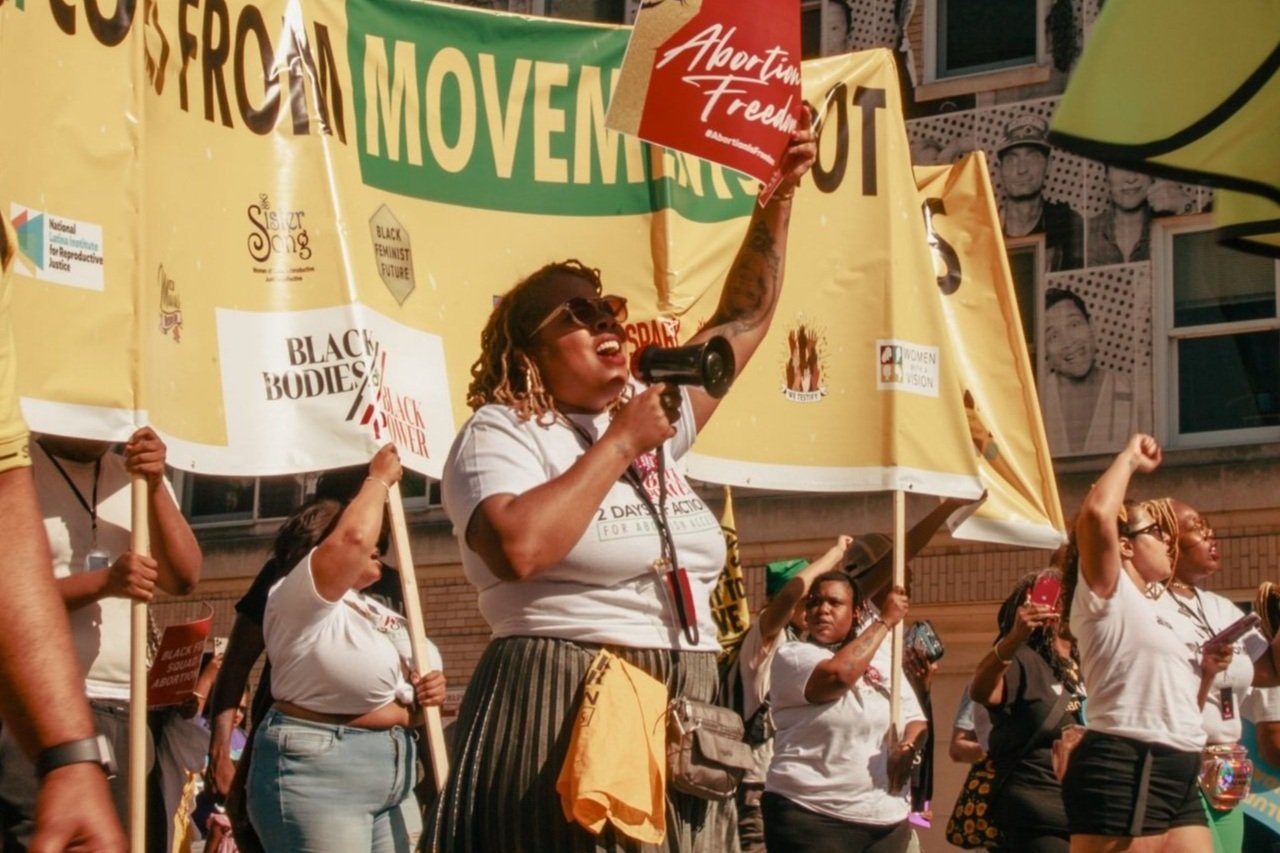Battling Injustice in the Fight for Reproductive Rights
Yaa Kwayana: Black Bodies for Black Power protests. Washington DC, June 2022
Words by Ana Maria Monjardino.
In a world increasingly polarised by the subject of reproductive rights, reproductive justice demands further thought. Despite the increasing interchangeability of the terms, the reproductive justice movement was founded following the exclusion of Black women from the 1990s reproductive rights movement.
Ultimately lacking an intersectional framework, the white mainstream movement refused to address how the needs and experiences of Black women might differ from their own. Coined by Kimberle Crenshaw in 1989, intersectionality illustrates how inequalities and privileges intersect to influence disparate socio-political experiences.
Without the same privileged ignorance as the mainstream, white feminist, movement, reproductive justice holds intersectionality at its core.
According to Sister Song, a woman of colour led advocacy group from Chicago, reproductive justice describes “the human right to maintain personal bodily autonomy, have children, not have children, and parent the children we have in safe and sustainable communities.” This must be regardless of a person’s race or nationality, physical ability or sexuality, gender or class.
Although there is no cohesive reproductive justice movement here in the UK, the Five X More campaign works diligently to highlight and change “Black women and birthing people’s maternal health outcomes.” In a society where Black women are four times more likely to die during pregnancy and childbirth, this mission is no small feat.
Institutional racism in the UK healthcare system is a key contributing factor to the culture of negligence which surrounds the reproductive healthcare of Black people in the UK. According to The Black Maternity Experience Report published by Five X More, “43% of women reported feeling discriminated against during their maternity care, with the most common reasons being race (51%), ethnicity (18%), age (17%) and class (7%).”
And in light of recent government action, there is further cause for concern. In July 2022, the UK government retracted its commitment to the protection of reproductive rights from a Foreign, Commonwealth and Development Office report on gender equality. It stands to reason that any potentially restrictive legislation would disproportionately impact Blackbirthing people, amongst others who have been marginalised from the mainstream fight.
But on top of affecting our choices, government action influences public opinion, as Dr. Tihesia Riley explained, “empowering a lot of people to voice their hopes for restrictions on abortions in the UK.” In an area like Northern Ireland, still torn between conflicting beliefs, government opposition poses the gravest threat.
I recently had the privilege of speaking to Hamsavani Rajswaren, former member of the abortion rights group Alliance for Choice. Hamsavani moved to Belfast, Northern Ireland, for University back in 2014. As a Tamil woman, born and raised in Singapore, going overseas to study in a predominantly white place was considered “a prestigious thing,” she told me. But it wasn’t long before she learnt the hideous reality of reproductive injustice in this supposedly developed society.
Back home she had never questioned abortion rights. So when she stumbled upon an abortion rights rally, during her first year in Belfast, she decided to get involved. But more often than not, at rallies and in meetings, she was ‘the only person of colour in the room’.
Photograph of Savita Hallapanavar, from a 2019 vigil. Credit Brendan Harkin.
The only group she knew of which was led by and for migrant women of colour was the Irish organisation MERJ: Migrants and Ethnic-minorities for Reproductive Justice. Founded in 2014, after the tragic death of Savita Hallapanavar, an South Indian migrant women, MERJ sought to provide “a platform for the often hidden faces and voices of migrants and ethnic minorities in Ireland that were all but missing from Irish feminism.”
In extreme pain and heavily bleeding, Savita made three requests for an abortion in the days leading up to her death. Living in Galway at the time, she was denied one on the grounds that Ireland was a Catholic country where abortion was a criminal offense. Without the healthcare she needed, her condition grew increasingly worse. She eventually died of cardiac arrest at 1.09am on October 28th, 2012. She was 31 years old.
Within weeks, streets across the country were drowned in a sea of burning light. But images of a smiling Savita, with dark brown eyes and a bright red smile, shone brightest of all.
Whilst her image was used widely by the mainstream movement to advance its cause, both her migrant-status and her race were largely ignored. Despite meeting some incredible activists, Hamsavani told me, “so many conversations at the time [in Northern Ireland] were just not very intersectional’, and so “we were not talking about the reasons why Savita died…”
Savita died seven years before the Northern-Irish referendum of 2019 which decriminalised the right to choose. But according to Alyson Kilpatrick, chief commissioner of the Northern Ireland Human Rights Commission, “women and girls are still faced with deplorable options,” with many still travelling to England for the procedure. And whilst many can not afford to, others lack the visa, or are deterred by the social stigma of making such a choice. Like Savita, they are then left to explore the ‘deplorable options’ nearby.
As demonstrated by the early mainstream movement, marginalisation will always hinder change. Because without an intersectional framework, there will be no reproductive justice. Without reproductive justice, the fight will go on.

